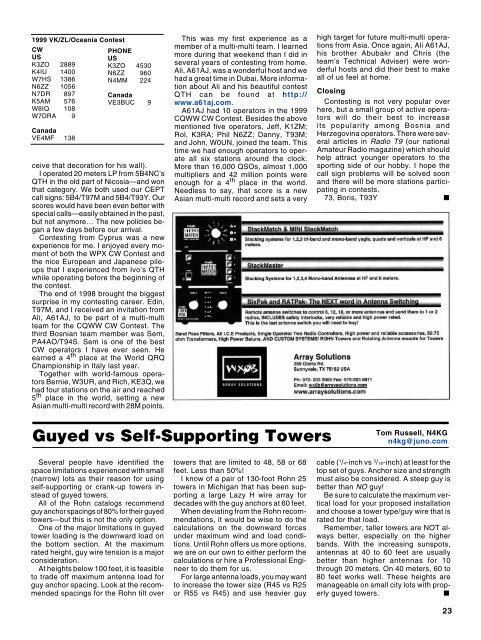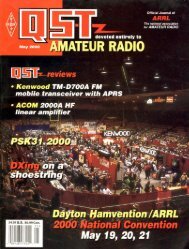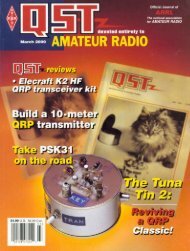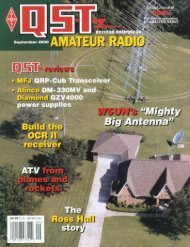September/October 2000 NCJ
September/October 2000 NCJ
September/October 2000 NCJ
You also want an ePaper? Increase the reach of your titles
YUMPU automatically turns print PDFs into web optimized ePapers that Google loves.
1999 VK/ZL/Oceania ContestCWUSK3ZO 2889K4IU 1400W7HS 1386N6ZZ 1056N7DR 897K5AM 576W8IQ 108W7DRA 9CanadaVE4MF 138PHONEUSK3ZO 4530N6ZZ 960N4MM 224CanadaVE3BUC 9ceive that decoration for his wall).I operated 20 meters LP from 5B4NC’sQTH in the old part of Nicosia—and wonthat category. We both used our CEPTcall signs: 5B4/T97M and 5B4/T93Y. Ourscores would have been even better withspecial calls—easily obtained in the past,but not anymore… The new policies begana few days before our arrival.Contesting from Cyprus was a newexperience for me. I enjoyed every momentof both the WPX CW Contest andthe nice European and Japanese pileupsthat I experienced from Ivo’s QTHwhile operating before the beginning ofthe contest.The end of 1998 brought the biggestsurprise in my contesting career. Edin,T97M, and I received an invitation fromAli, A61AJ, to be part of a multi-multiteam for the CQWW CW Contest. Thethird Bosnian team member was Sem,PA4AO/T94S. Sem is one of the bestCW operators I have ever seen. Heearned a 4 th place at the World QRQChampionship in Italy last year.Together with world-famous operatorsBernie, W3UR, and Rich, KE3Q, wehad four stations on the air and reached5 th place in the world, setting a newAsian multi-multi record with 28M points.This was my first experience as amember of a multi-multi team. I learnedmore during that weekend than I did inseveral years of contesting from home.Ali, A61AJ, was a wonderful host and wehad a great time in Dubai. More informationabout Ali and his beautiful contestQTH can be found at http://www.a61aj.com.A61AJ had 10 operators in the 1999CQWW CW Contest. Besides the abovementioned five operators, Jeff, K1ZM;Rol, K3RA; Phil N6ZZ; Danny, T93M;and John, W0UN, joined the team. Thistime we had enough operators to operateall six stations around the clock.More than 16,000 QSOs, almost 1,000multipliers and 42 million points wereenough for a 4 th place in the world.Needless to say, that score is a newAsian multi-multi record and sets a veryhigh target for future multi-multi operationsfrom Asia. Once again, Ali A61AJ,his brother Abubakr and Chris (theteam’s Technical Adviser) were wonderfulhosts and did their best to makeall of us feel at home.ClosingContesting is not very popular overhere, but a small group of active operatorswill do their best to increaseits popularity among Bosnia andHerzegovina operators. There were severalarticles in Radio T9 (our nationalAmateur Radio magazine) which shouldhelp attract younger operators to thesporting side of our hobby. I hope thecall sign problems will be solved soonand there will be more stations participatingin contests.73, Boris, T93Y ■Guyed vs Self-Supporting TowersTom Russell, N4KGn4kg@juno.comSeveral people have identified thespace limitations experienced with small(narrow) lots as their reason for usingself-supporting or crank-up towers insteadof guyed towers.All of the Rohn catalogs recommendguy anchor spacings of 80% for their guyedtowers—but this is not the only option.One of the major limitations in guyedtower loading is the downward load onthe bottom section. At the maximumrated height, guy wire tension is a majorconsideration.At heights below 100 feet, it is feasibleto trade off maximum antenna load forguy anchor spacing. Look at the recommendedspacings for the Rohn tilt overtowers that are limited to 48, 58 or 68feet. Less than 50%!I know of a pair of 130-foot Rohn 25towers in Michigan that has been supportinga large Lazy H wire array fordecades with the guy anchors at 60 feet.When deviating from the Rohn recommendations,it would be wise to do thecalculations on the downward forcesunder maximum wind and load conditions.Until Rohn offers us more options,we are on our own to either perform thecalculations or hire a Professional Engineerto do them for us.For large antenna loads, you may wantto increase the tower size (R45 vs R25or R55 vs R45) and use heavier guycable ( 1 /4-inch vs 3 /16-inch) at least for thetop set of guys. Anchor size and strengthmust also be considered. A steep guy isbetter than NO guy!Be sure to calculate the maximum verticalload for your proposed installationand choose a tower type/guy wire that israted for that load.Remember, taller towers are NOT alwaysbetter, especially on the higherbands. With the increasing sunspots,antennas at 40 to 60 feet are usuallybetter than higher antennas for 10through 20 meters. On 40 meters, 60 to80 feet works well. These heights aremanageable on small city lots with properlyguyed towers.■23
















